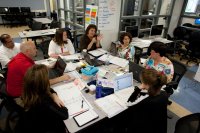Creating Effective Professional Learning Communities
If managed well, these teams can help teachers innovate in the classroom and improve student outcomes.
Your content has been saved!
Go to My Saved Content.Many teachers work to guide students to take academic risks that will help them learn. Can schools apply that idea to teacher learning as well?
The answer may be found in the collaboration achieved in professional learning communities (PLCs). PLCs—which harness “an ongoing process in which educators work collaboratively in recurring cycles of collective inquiry and action research to achieve better results for the students they serve”—are a common and proven practice to promote teacher collaboration that increases student achievement.
However, it is possible to fall into collaborative work that stifles innovation. This can happen, for example, if PLCs focus too heavily on common assessments and a common understanding of what students are learning, leading to common everything—students getting the same lesson plan in each class. I’ve heard administrators use the term “common experience” when setting expectations for teaching and learning. That strikes me as going too far.
Although this is grounded in wanting to ensure student success through consistency, it can stifle innovation, and one of the purposes of a PLC is to try out new strategies. The PLC is designed for teacher learning, and thus the team must balance risk taking and teacher autonomy with shared expectations for student learning. It’s important that teachers in a team have that clear understanding of purpose so that everyone feels safe to take risks.
A learning team constantly engages in a cycle of learning: analyzing data, setting goals, and learning individually and collaboratively, as well as implementing and adjusting practices to meet the needs of all learners. This process allows teachers to try new teaching practices and discover what’s working and what isn’t.
Determining Common Learning and Assessments
In PLCs, the fundamental questions teachers explore are: “What do we want students to learn?” and “How will we know if they have learned it?” These questions are foundational to any PLC, as they require teachers to come to a common understanding of the learning as well as common assessments that check for understanding.
PLC make this happen by prioritizing standards using specific criteria and then unpacking those standards, analyzing the nouns and verbs in the standards to understand which skills and concepts students will need to learn in order to be successful. Teachers identify what is hard to teach and what is hard to learn in the standards so that they can anticipate interventions and extensions.
It’s important to note that parts of this process call for tight alignment between teachers and don’t allow for the creativity and autonomy teachers may be used to. In order to achieve success for students, we do need some common practices. However, by agreeing as a team on what should be tightly aligned, we can set the stage for teacher autonomy and exploration of the art of teaching and instructional practice.
Making Space for Innovation
A PLC is constantly trying out new strategies to improve student learning, so individuals within the team must be given space to innovate. This is where the PLC should be only loosely aligned.
Teachers can never know what teaching works best for their students unless they are given the freedom to try out new strategies. PLCs can make this happen by having teachers collect evidence from common assessments and using data protocols to determine which strategies were most effective.
Ensuring That Teams Work Effectively
Sam Kaner coined the term Groan Zone to describe the space between a problem being posed and a solution being reached, and he described the divergent and convergent thinking that occurs there. Sometimes teachers in a PLC are afraid to engage in conflict or explore different ideas, worrying that even productive conflict signals that one is “not a team player.” Conversely, teachers may feel pressured to get work done and feel they don’t have time to spend in conflict.
But productive conflict can allow us to build better ideas and stronger teams, and PLCs should embrace productive conflict and create a space for it in order to innovate. PLCs can make this happen with clear norms as well as protocols to ensure that all voices are heard and that it is safe to engage in this conflict. It’s also helpful to make sure the projected outcome of a meeting is clear: Are we “generating ideas” or “making a decision”? This clarity can make space for open conversation.
PLCs need strong facilitators in order to engage in conversations that promote learning, risk taking, and innovation. However, the facilitators or leaders of those teams may be torn between advocating for ideas and managing the complex process of moving the team forward. This can lead to situations where team members have a facilitator who is strongly advocating for an idea rather than allowing for all voices to be heard, and team members may not feel safe to speak up or take risks. If facilitators need to advocate, they should select someone else to facilitate, in order to continue to balance advocacy for new ideas against team consensus and integration.
I recommend clear decision-making process like the Gradients of Agreement structure, which allows for decision making that honors the Groan Zone and divergent thinking while still moving toward convergent thinking and consensus decision-making.
PLCs are the lifeblood of innovation and risk taking in school. When structured well, they can be teams that constantly learn together and work to discover what is best for students.
